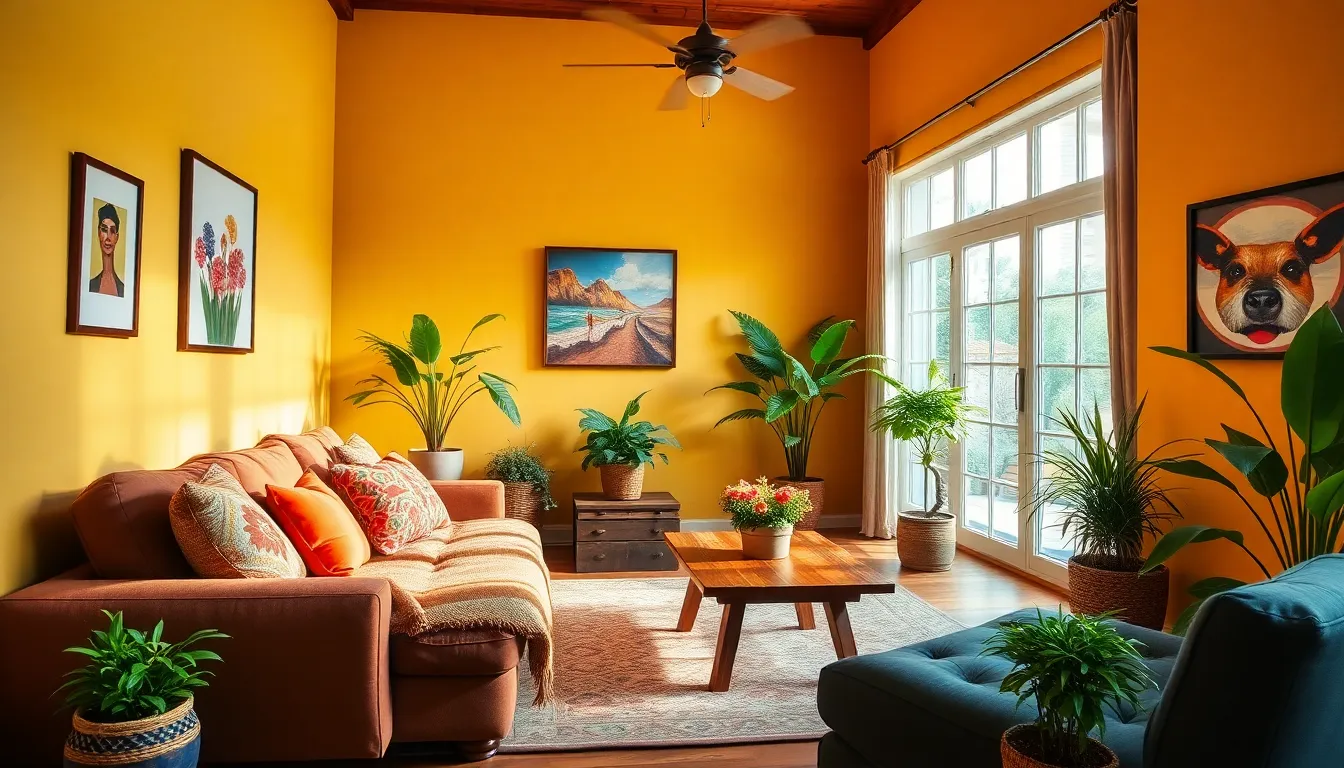Table of Contents
ToggleImagine walking into a room that wraps you in a cozy embrace, where every shade whispers comfort and warmth. That’s the magic of warm tones in interior design. From soft yellows to rich terracottas, these colors don’t just decorate walls; they create an inviting atmosphere that makes you want to kick off your shoes and stay awhile.
Warm tones can turn even the coldest of spaces into a snug retreat. They evoke feelings of happiness and relaxation, transforming your home into a haven that feels like a big hug from your favorite fuzzy blanket. So, if you’re ready to ditch the sterile whites and drab grays, let’s dive into how warm tones can breathe life into your interiors and make every corner feel like a sunny day, even if it’s pouring outside.
What Are Warm Tones Interior?
Warm tones in interior design refer to colors that exude comfort and coziness. These hues include shades like soft yellows, oranges, reds, and browns, which evoke feelings of warmth. Colors like terracotta and sand create intimate environments that promote relaxation.
Designers often utilize warm tones to transform a space into a welcoming retreat. Rooms painted in warm tones can feel more inviting than those dominated by cool colors. Adding elements like warm wooden furniture enhances the cozy atmosphere further.
Functionality plays a role in selecting warm tones. Bright yellows can enliven kitchens and dining areas, while deeper oranges may suit living rooms or bedrooms. Each color contributes a unique vibe, enhancing comfort and creating a harmonious flow.
To achieve balance, combining warm tones with neutral shades proves effective. Light creams or soft grays pair well with rich browns, ensuring the space remains versatile and not overwhelming. Accessories in warm colors can also add personality without overpowering the overall design.
In spaces receiving ample natural light, warm tones can brighten rooms. They tend to reflect and amplify sunlight, creating an inviting ambiance. During colder months, warm colors provide psychological warmth, combating feelings of chilliness.
Incorporating warm tones encourages a sense of connection within a home. Family gatherings in a warmly toned living area foster intimacy and togetherness. Choosing these colors signals an open, friendly environment, making residents and guests feel at ease.
Benefits of Warm Tones Interior
Warm tones in interior design offer several advantages, enhancing both comfort and ambiance within a space. These colors create inviting atmospheres that residents appreciate, making homes feel more enjoyable and relaxed.
Enhanced Comfort
Warm tones naturally evoke feelings of comfort and coziness. Spaces adorned in golden yellows or soft terracottas feel inviting, promoting relaxation. Warm hues facilitate a more welcoming environment, making occupants feel at ease in their surroundings. Surrounding oneself with these shades can reduce stress levels and foster a sense of well-being. Additionally, warm wooden furniture complements these colors, enhancing overall comfort. Living areas transform into cozy retreats where comfort reigns.
Improved Ambiance
Warm colors significantly improve the ambiance of a room, creating a lively atmosphere. Bright yellows and rich oranges infuse energy, while deeper reds cultivate intimacy. These hues interact beautifully with natural light, maximizing brightness during the day. Light cream or soft gray neutrals balance warm tones without overwhelming the senses. Depending on the time of year, warm tones maintain a sense of psychological warmth, especially during colder months. Inviting guests into a home painted in warm shades contributes to a friendly, open atmosphere, enriching social interactions.
Popular Warm Colors
Warm colors play a significant role in creating inviting interiors. These hues can transform any space into a peaceful yet lively area.
Earthy Shades
Earthy shades like terracotta and warm browns add depth to interiors. Designers often use these colors to create a grounded atmosphere. Natural elements such as wooden furniture enhance the effectiveness of these shades. Rich terracotta floors, for example, bring warmth to kitchens and entryways. Each earthy tone contributes to a serene and comforting environment. Spaces infused with deep browns feel cozy and connected to nature.
Soft Pastels
Soft pastels like muted yellows and peach pinks introduce a gentle warmth. These colors are perfect for bedrooms or nurseries, promoting relaxation and calmness. Light pastel shades harmonize beautifully with neutral palettes, adding depth without overwhelming. They also work well in bright spaces, allowing rooms to maintain a fresh and airy feel. Incorporating soft pastels can create delightful contrasts with darker tones, fostering visual interest.
Rich Jewel Tones
Rich jewel tones such as ruby reds and deep oranges create striking impressions. These colors bring vibrancy and warmth to living spaces, enhancing energy levels. They evoke a sense of luxury and sophistication when used in textiles and accents. Jewel tones complement neutral backdrops, creating a dramatic visual appeal. Using these vibrant hues can also foster a sense of intimacy, drawing people together in common areas. Each jewel tone contributes to a welcoming environment, making homes feel alive and inviting.
Tips for Designing a Warm Tones Interior
Designing with warm tones involves thoughtful choices that enhance comfort and ambiance. Consider the following strategies to create a cozy space.
Choosing the Right Palette
Selecting a warm colors palette includes soft yellows, rich oranges, and earthy reds. These hues evoke feelings of comfort and happiness. Opt for shades that resonate with personal preferences and the intended mood of each room. Deep terracotta works well for living areas. Soft peach creates an inviting atmosphere in bedrooms. Experimenting with different shades can lead to unique combinations that enhance the overall aesthetic.
Balancing with Neutrals
Incorporating neutrals helps balance warm tones. Light creams and soft grays prevent overwhelming the space. Balanced designs maintain versatility while enhancing warmth. Pair warm yellows with cream for a tranquil kitchen. Use soft gray alongside rich browns for a sophisticated living room. Neutral shades create a calm backdrop that allows warm colors to shine without distraction.
Accent Elements
Using accent pieces can elevate the design without overpowering warm tones. Choose accessories like throw pillows, artwork, and decorative items that reflect warm hues. Incorporate terracotta vases or amber glass for subtle richness. Decorative lighting can enhance warm colors, creating inviting spaces. Rugs featuring warm-toned patterns can ground a room, adding warmth underfoot. Thoughtful accents contribute to a cohesive design while reinforcing warmth and comfort in any area.
Embracing warm tones in interior design can significantly elevate the atmosphere of any space. These inviting colors foster a sense of comfort and connection that transforms homes into cozy retreats. By thoughtfully selecting warm hues and balancing them with neutrals, individuals can create environments that are both stylish and welcoming.
Incorporating elements like wooden furniture and accent pieces in warm shades enhances the overall aesthetic while promoting relaxation. The result is a harmonious space that encourages social interactions and nurtures well-being. With warm tones, each room becomes a sanctuary that reflects personal style and invites joy into everyday living.







